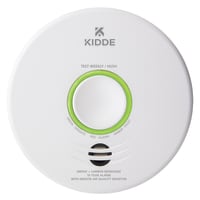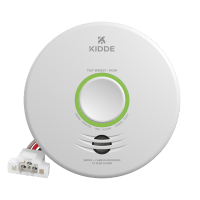Carbon monoxide (CO) levels in a home are typically measured over time. Carbon monoxide detectors are time-weighted alarms. The way a time-weighted alarm works is by measuring the buildup of carbon monoxide in a house as time passes.
For a person to begin feeling the effects of carbon monoxide poisoning, they would need to be exposed to a carbon monoxide level of 50 parts per million (PPM) for eight hours.
Different carbon monoxide detectors will sound at the detection of varying CO ppm levels. A CO sensor needs to meet the sensitivity requirements of Underwriters Laboratories UL2034 Single and Multiple Station Carbon Monoxide Alarms. Per these requirements, standard CO sensors will typically not alarm at levels below 30 ppm.
Carbon monoxide alarms with ultra-sensitive detection, however, will indicate low levels of CO below 30ppm which may have health implications for those suffering from pre-existing conditions.
How Much Carbon Monoxide Is Dangerous?
Levels of carbon monoxide exposure range from low to dangerous:
- Low level: 50 PPM and less
- Mid-level: Between 51 PPM and 100 PPM
- High level: Greater than 101 PPM if no one is experiencing symptoms
- Dangerous level: Greater than 101 PPM if someone is experiencing symptoms
When Will Carbon Monoxide Levels Set Off Your Alarm?
| Carbon Monoxide Level | Alarm Response Time |
| 40 PPM | 10 hours |
| 50 PPM | 8 hours |
| 70 PPM | 1 to 4 hours |
| 150 PPM | 10 to 50 minutes |
| 400 PPM | 4 to 15 minutes |
Carbon Monoxide Levels and Their Symptoms
If your carbon monoxide alarm sounds, or you suspect you are experiencing symptoms of carbon monoxide poisoning, you should immediately leave your home and call 9-1-1. Here are some of the symptoms you can expect from carbon monoxide exposure.
| 50 PPM | None for healthy adults. According to the Occupational Safety & Health Administration (OSHA), this is the maximum allowable concentration for continuous exposure for healthy adults in any eight-hour period. |
| 200 PPM | Slight headache, fatigue, dizziness, and nausea after two to three hours. |
| 400 PPM | Frontal headaches with one to two hours. Life threatening after three hours. |
| 800 PPM | Dizziness, nausea, and convulsions within 45 minutes. Unconsciousness within two hours. Death within two to three hours. |
| 1,600 PPM | Headache, dizziness and nausea within 20 minutes. Death within one hour. |
For more information about your specific alarm, refer to your user’s manual.
In order for CO alarms to detect carbon monoxide accurately, it’s important to properly place and install alarms. Become familiar with frequently asked questions on the use and capabilities of carbon monoxide detectors to help protect your home and family.





